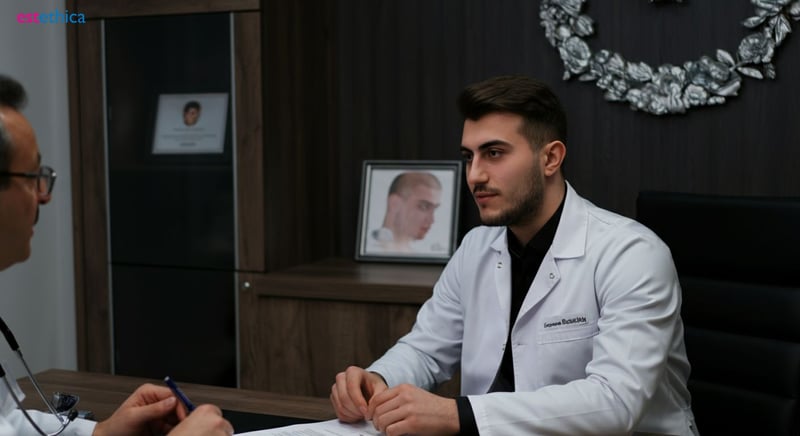Gynecomastia Solutions: Transform Your Confidence
Explore effective gynecomastia solutions to enhance your confidence and well-being.
Gynecomastia, commonly known as enlarged male breasts, is a condition that can impact confidence and self-esteem. Understanding the underlying causes and available treatment options is the first step towards reclaiming your comfort and confidence.
Understanding Gynecomastia: Causes and Symptoms
Common Causes of Gynecomastia
Gynecomastia, characterized by enlarged male breasts, can arise from several factors. Hormonal imbalances, particularly an increase in estrogen or a decrease in testosterone, are primary contributors. Medications such as anti-androgens, used for prostate conditions, and certain antidepressants can also lead to gynecomastia. Additionally, underlying health conditions like liver disease or hyperthyroidism may play a role.
Recognizing Symptoms Early
Identifying gynecomastia early is crucial for effective management. Symptoms typically include swollen breast tissue and tenderness. In some cases, individuals may experience mild gyno, where the enlargement is less pronounced but still noticeable. Understanding the various treatment options can aid in addressing these symptoms effectively.
Factors Influencing Gynecomastia
- Hormonal changes during puberty or aging can trigger gynecomastia.
- Use of anabolic steroids or recreational drugs may contribute to the condition.
- Genetic predispositions can increase susceptibility to developing gynecomastia.
Each of these factors can influence the severity and progression of gynecomastia, making it essential to consider them when evaluating symptoms.
Steps to Address Gynecomastia
- Consult a healthcare professional for an accurate diagnosis.
- Explore natural gynecomastia treatment options, such as lifestyle changes.
- Consider surgical interventions if symptoms persist or worsen.
By following these steps, individuals can effectively manage gynecomastia and reduce its impact on their lives.

Natural Remedies: Can Gynecomastia Be Treated Without Surgery?
Exploring Non-Surgical Approaches
For those seeking alternatives to gynecomastia surgery, natural remedies offer a promising avenue. These methods focus on lifestyle changes and holistic approaches to reduce mild gyno. Understanding how to gynecomastia reduced naturally involves a combination of dietary adjustments, targeted exercises, and herbal supplements.
Dietary Changes for Gynecomastia Reduction
- Incorporate foods rich in zinc and vitamin D to balance hormones.
- Avoid processed foods and sugars to reduce estrogen levels.
- Include cruciferous vegetables like broccoli to support liver health.
These dietary changes can help manage hormonal imbalances, a key factor in gynecomastia grading.
Exercise Routines to Target Chest Fat
- Start with cardio exercises to burn overall body fat.
- Incorporate strength training focused on the chest area.
- Maintain consistency to see gradual improvements.
Regular exercise not only aids in male breast reduction but also boosts overall health and confidence.

Choosing the Right Surgeon: What to Look For
Evaluating Surgeon Credentials
When considering gynecomastia surgery, it's essential to evaluate a surgeon's credentials. Look for board certifications in plastic surgery, which indicate a high level of training and expertise. Additionally, verify their experience with male breast reduction procedures, as specialization can significantly impact outcomes. For instance, a surgeon who has performed numerous gynecomastia surgeries is likely to have refined techniques that enhance results. Furthermore, check for any affiliations with reputable medical organizations, as these can be indicators of a surgeon's commitment to maintaining high standards in their practice.
Understanding the Consultation Process
A consultation is a critical step in selecting the right surgeon for gynecomastia surgery. During this meeting, assess the surgeon's communication style and willingness to address your concerns. A thorough consultation should include a discussion of gynecomastia grading, potential risks, and expected outcomes. Additionally, inquire about their approach to post-operative care, as this can influence recovery time and overall satisfaction. For example, a surgeon who provides detailed aftercare instructions and follow-up appointments demonstrates a commitment to patient well-being. This process not only helps in understanding how to gynecomastia reduced effectively but also builds trust and confidence in the surgeon's abilities.
Factors Influencing Gynecomastia Surgery Costs
- Surgeon's experience and reputation can affect pricing.
- Geographic location influences the cost of medical procedures.
- Complexity of the surgery may lead to variations in cost.
While cost is a consideration, prioritize the surgeon's expertise and patient outcomes for the best results.
- Research and shortlist potential surgeons based on credentials.
- Schedule consultations to evaluate their approach and expertise.
- Make an informed decision prioritizing experience and patient care.
By following these steps, you can select a qualified surgeon who aligns with your needs and expectations for gynecomastia surgery.

Recovery Insights: What to Expect Post-Surgery
Managing Post-Surgery Discomfort
Post-operative recovery from gynecomastia surgery involves managing discomfort and swelling. Patients often experience mild gyno symptoms such as tenderness and tightness in the chest area. Following the surgeon's instructions, including wearing compression garments, can significantly aid in reducing these symptoms. For instance, a patient who diligently adheres to post-surgery guidelines may notice a decrease in swelling within the first two weeks. Additionally, keeping the surgical area clean and dry is crucial to prevent infections and promote healing. Understanding how to gynecomastia reduced through proper care can enhance recovery outcomes.
Returning to Normal Activities
The timeline for resuming regular activities after gynecomastia surgery varies. Generally, patients can return to light activities within a week, while more strenuous exercises may require a longer wait. For example, a patient who undergoes male breast reduction might be able to resume desk work after a week but should avoid heavy lifting for at least four weeks. It's essential to listen to your body and consult with your surgeon before engaging in any physical activities. This gradual approach not only ensures a smoother recovery but also minimizes the risk of complications.
Factors Influencing Recovery Time
- Individual health conditions can affect the healing process.
- The extent of the surgery influences recovery duration.
- Adherence to post-operative care instructions is crucial for optimal recovery.
Understanding these factors can help set realistic expectations and prepare for a successful recovery journey.
- Follow all post-operative instructions provided by your surgeon.
- Attend all scheduled follow-up appointments for monitoring progress.
- Gradually reintroduce activities based on your surgeon's advice.
By adhering to these steps, patients can enhance their recovery experience and achieve the desired results from gynecomastia surgery.
Latest Treatment Trends and Innovations
Innovative Techniques in Gynecomastia Surgery
Recent advancements in gynecomastia surgery have focused on minimizing invasiveness while maximizing results. Techniques such as ultrasound-assisted liposuction and laser-assisted lipolysis are gaining popularity. These methods allow for precise targeting of fatty tissue, reducing recovery time and enhancing outcomes. For instance, a patient undergoing ultrasound-assisted liposuction may experience less bruising and swelling compared to traditional methods. Additionally, these techniques can be tailored to address mild gyno, providing a customized approach to male breast reduction. As technology evolves, these innovations continue to improve the effectiveness and safety of gynecomastia treatments.
Emerging Non-Surgical Treatments
Beyond surgical options, non-invasive treatments are also making strides in gynecomastia management. Cryolipolysis, commonly known as fat freezing, is being explored for its potential to reduce enlarged male breasts without surgery. This method targets and destroys fat cells through controlled cooling, offering a non-surgical alternative for those with mild gyno. Another promising development is the use of radiofrequency energy to tighten skin and reduce fat. These non-surgical treatments provide additional options for individuals seeking less invasive solutions to gynecomastia.
Factors Influencing Treatment Choice
- Severity of gynecomastia affects the suitability of treatment options.
- Patient's overall health and medical history play a crucial role.
- Personal preferences regarding invasiveness and recovery time.
Understanding these factors can help individuals make informed decisions about the most appropriate treatment for their needs.
- Consult with a specialist to explore the latest treatment options.
- Evaluate the benefits and risks of surgical versus non-surgical methods.
- Choose a treatment plan that aligns with personal goals and lifestyle.
By considering these steps, individuals can navigate the evolving landscape of gynecomastia treatments effectively.
Patient Experiences and Testimonials
Journey to Confidence: Real Stories
Hearing from those who have undergone gynecomastia treatment can be incredibly reassuring. Many patients describe their journey as transformative, not only physically but emotionally. For instance, one individual shared how addressing his mild gyno through surgery significantly boosted his self-esteem, allowing him to participate in activities he previously avoided. Another patient highlighted the importance of choosing the right surgeon, noting that their expertise in gynecomastia grading ensured a tailored approach to his treatment. These stories emphasize the profound impact that effective gynecomastia treatment can have on a person's life.
Common Challenges and Triumphs
While the path to overcoming gynecomastia can present challenges, many patients find the results well worth the effort. Some individuals face initial apprehension about surgery, but testimonials often reveal that post-operative care and support play a crucial role in easing these concerns. For example, a patient recounted how following a structured recovery plan helped him return to normal activities sooner than expected. Others have shared their experiences with non-surgical treatments, such as lifestyle changes, which have successfully reduced symptoms. These accounts highlight the diverse paths to achieving male breast reduction and the triumphs that follow.
Factors Influencing Patient Satisfaction
- Clear communication with the healthcare team enhances trust and satisfaction.
- Realistic expectations set during consultations lead to greater contentment with results.
- Comprehensive post-operative support contributes to a smoother recovery experience.
Understanding these factors can help individuals make informed decisions and improve their overall treatment journey.
- Research patient testimonials to gain insight into different treatment experiences.
- Identify common themes and advice shared by those who have undergone gynecomastia treatment.
- Apply these insights to your own decision-making process for a more informed approach.
By learning from others' experiences, individuals can better navigate their own journey towards confidence and improved aesthetics.
Innovative Techniques in Gynecomastia Surgery
Comprehensive Post-Surgery Care and Recovery Insights
Frequently Asked Questions
What are the common causes of gynecomastia?
Can gynecomastia be treated without surgery?
What should I consider when choosing a surgeon for gynecomastia surgery?
What can I expect during the recovery period after gynecomastia surgery?
Are there any innovative techniques available for gynecomastia treatment?
Discover the Path to Your Healthiest Self with estethica's Expert Care!
📞 Call Now for a Free Consultation!